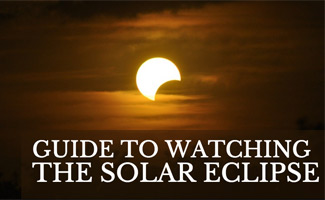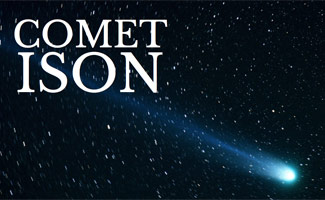To keep the lights on, we receive affiliate commissions via some of our links. Rankings remain impartial. Our review process.

Is This Comet ISON?
No. This is an asteroid named 2012 DA14. There is actually a significant difference between a comet and an asteroid.
What is a Comet?
A comet is made up of rocky material, dust and ice. These celestial bodies formed billions of years ago when the solar system was just beginning. Comets form further from the sun than asteroids and as a result the ice within them would not melt. As these comets move closer to the sun though, the ice that is within them begins to melt and vaporize which is what makes up the “tail” that is seen on all comets. Asteroids do not have these “tails.” The orbital pattern of a comet is quite extended and elongated. Comets are also fewer in number than asteroids with just 3,472 comets known in the scientific community.
What is an Asteroid?
An asteroid is comprised of rocky material and metals. As with comets, asteroids formed billions of years ago at the beginning of the solar system. Since asteroids formed closer to the sun than comets, they do not contain any ice at all which leads to the absence of a tail. The orbital pattern of an asteroid is also quite different from that of a comet and is short and circular in comparison. Asteroids also tend to gather together in to “asteroid belts” where comets do not. There are currently millions of asteroids within our solar system that vary in size considerably.
What Do We Know About Asteroid 2012 DA14?
Asteroid 2012 DA14 was first noted approximately one year ago in February of 2012 when it was detected by La Sagra Observatory in south Spain. Since its first discovery, researchers have been keeping an eye on it and tracking its movement. The asteroid is currently around 150 feet wide and while there were some rumors that it would hit the Earth and even “decimate London”, there is no evidence to prove such a theory. Researchers say that Asteroid 2012 DA14 will reach its closest point to the Earth at around 17,200 miles away on Friday February 15, 2013 at 7:30PM UK time. Asteroid 2012 DA14 is considered to be an NEO or a Near Earth Object. NEO’s are dangerous entities in that they are not so large that they are always noted.
What about Our Cell Phones?
While there is no chance that the asteroid will strike the Earth, scientists have said that there is a remote possibility that it will strike a telecommunication or weather satellite. Currently there are more than one hundred telecommunication and weather satellites that orbit the Earth and depending upon the path of the asteroid there is a chance that it can strike any one of these. These satellites which are responsible for “pinging” data between cellular phones and while the chances that one of them will be hit are remote, there is still a possibility.
It is estimated that Asteroid 2012 DA14 will move at anywhere from 12,427 mph to 18,641 mph and will pass through the orbits of the high geostationary satellites that orbit the Earth. While the asteroid will pass through this area, according to Nottingham Trent University astronomer, Dr Dan Brown, the area that we are talking about is considerably large and so, it is much more likely that the asteroid will hit “space junk” if it does indeed strike anything. The impact of the asteroid striking space junk however, will be barely a blip on the radar according to Dr. Brown.
Will We Be Safe From Asteroid 2012 DA14?
Scientists who have been tracking the asteroid since its discovery state that at 17,200 miles away safety should not be a concern. With that said, this distance is considered quite minimal in terms of astronomy making the event somewhat of a “narrow miss.” As for those who are concerned about the International Space Station, the ISS orbits at just a few hundred kilometers above Earth and is in no danger of being struck by the asteroid in question.
What Could Happen if Asteroid 2012 DA14 Struck Earth?
Calculations show that there is absolutely no possibility that this asteroid will strike Earth; however, researchers have an idea of what could happen if it did. Back in 1908 a meteor of similar size to Asteroid 2012 DA14 struck an area of Siberia known as Tunguska. The meteor exploded just above the ground and generated a blast more than 1,000 times that of the atom bomb that was dropped on Hiroshima. For an area of 830 square miles entire forests were flattened but fortunately human civilization was not wiped out in the area. Had the meteor impacted on the ground in a more populated area such as London, civilization and everything else within impact range would have been completely decimated.
Can We See Asteroid 2012 DA14?
For those wishing to watch as the asteroid passes, it will be visible with binoculars or a telescope, but not to the naked eye. The asteroid will, according to Dr. Brown, be low to the north-eastern horizon and visible as it passes through the Leo constellation and The Plough for those viewing the asteroid from the UK.
Why is Asteroid 2012 DA14 So Interesting?
Due to the fact that Asteroid 2012 DA14 is coming so “close” to the planet Earth, astronomers and other researchers hope to learn a lot from its passing. Researchers plan to study the asteroid via radar as it flies past the Earth in an attempt to learn more about its structure and its composition. It is the hope of researchers that doing so will be able to provide information on how to tackle any future asteroids that do pose a threat to the planet. Many people mistakenly believe that if an asteroid similar to DA14 were to be on a trajectory aimed directly at Earth, that we could simply explode it before it strikes. This plan, according to researchers, would result in deadly debris. Rather, scientists hope that from studying DA14 they can figure a way to nudge any Earth-bound asteroid away from Earth and on to a different trajectory.
Is Asteroid 2012 DA14 One in a Million?
Asteroid 2012 DA14 is not quite one in a million; in fact as an asteroid it is more “one of a million.” Currently astronomers are tracking as many as four hundred of these “Near Earth Objects” that are believed to be a potential threat. Some of the NEO’s that are currently being tracked are the same size as DA14, but amazingly, some are even larger!
Approximately 15 years ago NASA launched an NEO program designed to discover all asteroids which had the potential of causing an “Extinction event.” These asteroids were all asteroids that were .62 miles in diameter and larger. Since its inception the organization has also begun to track much smaller asteroids as well. It is the hope of researchers within the program that some time in the near future more of these smaller NEO’s will be caught and researched with the goal of preventing potentially dangerous space objects.
Video: ScienceCast Coverage
Was the Russian Meteor Related to Asteroid 2012 DA14?
With asteroid 2012 DA14 reaching its closest point to the planet Earth on Friday, February 15th, 2013 it is no wonder that the Russian meteorite is being linked to it. The truth of the matter is however, that the meteor, which exploded in the sky just over the Russian city of Chelyabinsk had absolutely no correlation to the asteroid 2012 DA14. For some, the time of the meteor’s explosion may seem like more than a coincidence but that is exactly what it was. According to NASA officials, the asteroid and the meteor had a completely different trajectory which, in an astronomical sense, means that they are completely unrelated.
The Russian meteor event which is being referred to as just that, is similar to the 2012 DA14 asteroid in one sense, it too is being compared to the 1908 meteor explosion over the Tunguska River in Siberia. The time span of more than one hundred years between two such devastating events indicates that a meteor event so significant is a rare occurrence. The Russian meteor blew apart over the town of Chelyabinsk at 22:20 EST on February 14th or 3:20 GMT on February 15th. At one point during the meteor’s journey it outshined the sun but ultimately its size would be downplayed by the much larger 2012 DA14 asteroid.
Statistics on the February 15, 2013 Russian Meteor vs. the 2012 DA14 Asteroid
For those interested in a comparison of the Russian meteor and the 2012 DA14 asteroid, let us first take a look at the statistics on the Russian meteor.
Name: Russian meteor or the Chelyabinsk meteor
Mass: 10,000 tons (20,000,000 lbs)
Diameter: 49 feet
Speed: 40,000 mph at the time of explosion
Impact: The explosion caused by the meteor injured more than 1,400 people and caused damage to more than 3,000 buildings that suffered from collapsed roofs and broken windows. It was estimated to have a blast equivalent of 470 kilotons!
Location: Just over the city of Chelyabinsk, Russia approximately 10 to 15 mi above the ground.
Now let us compare those to the statistics on the 2012 DA14 asteroid.
Name: 2012 DA14 asteroid
Mass: 190,000 tons
Diameter: 160 feet
Speed: 17,400 mph
Impact: No impact
Location: At its closest point, 2012 DA14 was 17,200 miles away from the planet Earth and was closest to Indonesia.
Another Celestial Body Sighting
In addition to the sighting of the Russian meteor and the 2012 DA14 asteroid, another celestial body was spotted over San Francisco. On Friday, February 15th at 22:45 pm EST a “fireball” was spotted over the San Francisco Bay area. Unlike the Russian meteor and the 2012 DA14 asteroid however, this fireball had little to show off. The fireball, as it has been described, was said to put on a light show for those who were watching it but aside from that there was little else seen. For those who are wondering, this fireball also had no correlation to either the Russian meteor or the 2012 DA14 asteroid. One witness to the fireball described it as being blue in color and many have referred to it as a meteor. Another eyewitness described the meteor as bright yellow in color. According to astronomer Gerald McKeegan, the “fireball” was nothing special, he believes it to have been a sporadic meteor. This type of meteor can fall as often as a couple of times a day and is responsible for bringing up to 15,000 tons of space debris to Earth each year.
What is the Difference between a Meteor, Meteorite, Falling Star and Shooting Star?
We have already covered the difference between a comet and a meteor but what about some of the other terms that we have mentioned? Some have referred to the San Francisco Bay meteor as a “shooting star” however and this is not a misnomer. Meteors are often referred to as shooting stars or falling stars. While the scientific community much prefers to refer to these bodies as meteors, it is not incorrect to also refer to them as falling stars or shooting stars.
But what is the difference between a meteor versus a meteorite? The terms meteor and meteorite are used to refer to two phases of the same body. When a meteor is seen it is because it has been heated by the friction in the Earth’s atmosphere. Once that meteor reaches the Earth’s surface however, it is referred to as a meteorite.
What Does All This Space Activity Mean?
Even after asteroid 2012 DA14 has passed there are conspiracy theorists that believe that it was a warning from space that should have been heeded. Just what these people believe should be done to “remedy” something that has happened multiple times throughout Earth’s history, is unknown. Certainly it is possible to blame social issues like global warming for anything and everything, but in the case of 2012 DA14, it is doubtful that anything but sheer happenstance played a role. A meteorite of similar size to DA14 struck Tunguska in 1908, a period when pollution and manmade devastation on the planet was considerably less. Then there is the fact that a similar asteroid was noted in the 1800’s, a time period when the level of manmade pollution to the Earth was even less.
So if it’s not manmade, what is all of this space activity about? Since the creation of the universe there have been dust particles, minerals, rocks and ice among other things floating around in space. As these items move around throughout space they can be caught in the gravitational pull of the various planets causing them to have an altered trajectory. As these celestial bodies get pulled off their trajectory by gravity, they can move in to the danger zone for planets because of the potential for impact. Celestial bodies that come within 1.3 astronomical units of the sun are referred to as Near Earth Objects. The truth is that no one really knows of a cause for these celestial bodies landing where they do or passing where they do other than to say that it was a natural process of gravity and the projected trajectory for a specific spatial body. The three celestial bodies that fell between February 14 and 15th were simply meant to strike where they fell… or not as the case may be.
Tagged With:

